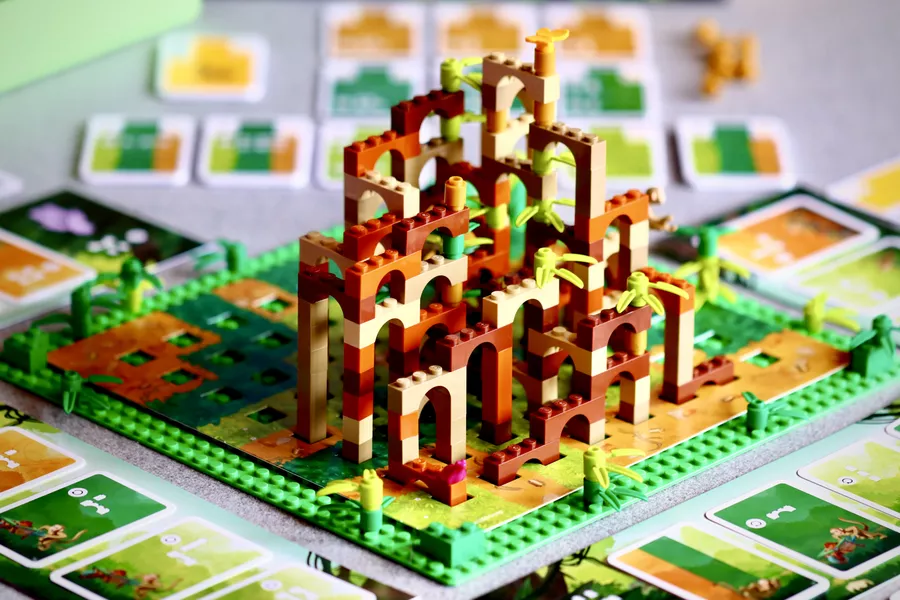Monkey Palace Board Game Review
It’s been over a decade since The LEGO Group released their last board game, and honestly, those original games were pretty bad. The LEGO Group has partnered with Asmodee to begin releasing a number of LEGO themed board games, the first of which is Monkey Palace. Are you the ultimate Monkey King, and have the most banana points at the end of the game? Let’s take a look.
Colour doesn’t matter. That’s what the game tells you, and for the most part that is true. Except until color does matter. Most of the game pieces don’t matter, and whatever colour you use is fine. When it does matter is when you are placing decoration pieces (dark green leaves, light green leaves, and gold/tan/brown cylinder pieces). It might sound weird talking about this off the top, but I think it’s important to understand this before we hop into what you are actually doing.
So what are we doing? Building arches, higher and higher off the ground. The concept of the game makes you feel like this is a family friendly experience. It’s a 10+ game experience, but I actually think this is a harder game than the brand or concept lets on. There is a lot going on here. You will be getting LEGO elements to build with, and will have to build stairs that, on your turn, must continue upwards. The more LEGO elements that end up on the board, the tougher the decisions become. Where can you best maximize your pieces?
Each turn, once you’ve built your acres, you will earn banana points that you can then spend on cards. The more steps you build in the Palace, the more banana points you earn. One step equals one banana point, so three steps equals three banana points. Also, depending on where you start your staircase, you will place one of three colored decoration items. If you have the highest decoration of that colour, you get an additional banana point.
So what are these points? First and foremost, you will use these points to purchase cards from a central supply. These cards will provide you instant pieces to add to your pool, as well as pieces you will earn at the end of every turn. This is how you will grow your pool. These cards are also worth points at the end of the game equal to the number of banana points spent.
The game continues with players placing pieces and selecting cards from the central supply until there are no pieces left to choose, after which players score their points and see who wins. There are alternative ways to play with the butterfly and frog pieces, but ultimately this is the basic flow of the game.
LEGO is LEGO, so the quality of the production is top notch. I love that they used different colors for the arches, not only because it provides a variety of new LEGO elements in different colors, but it’s also MUCH easier to see and count steps that have been created each round. It’s great to see the arches grow, but when you go hard on one color, it can be hard to remember where you started, or how far you’ve gone. It’s a brilliant little production element that really shows that the design team was looking to create a great gaming experience, not just cash in on the LEGO brand.
As we said off the top, this isn’t as easy of a game as you might think. I do believe that after a few plays, this will make a great family game with older kids, but it does take a bit to understand. Our 10 year old loves board games and LEGO, but had his own issues trying to figure out the best strategy to use in order to win. As we have said many times before, this game is easy enough for anyone to play, but it’s pretty hard to master and understand.
To me, that’s actually a strength here. Past board games produced by The LEGO Group were aimed at LEGO enthusiasts. They had cool pieces, neat displays, and were based on some great IPs as well. This time around, The LEGO Group and Asmodee are aiming to first attract a very different fan base – board game players. And to that end, I think they have definitely succeeded.
Regardless if you love LEGO or not, this is a fantastic game that’s worth your time. It’s simple enough that it won’t take much for players to understand how it works, but deep enough strategically that you’ll need to play a good number of times before you’ve felt you have mastered the experience. Don’t overlook Monkey Palace simply because it has LEGO stamped on the cover – this is a game you might not want to miss out on!

